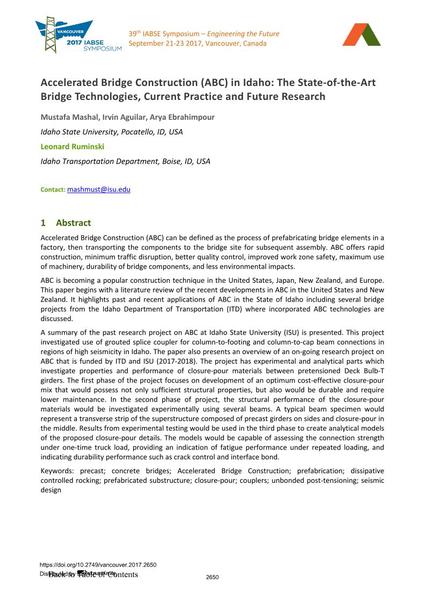Accelerated Bridge Construction (ABC) in Idaho: The State-of-the-Art Bridge Technologies, Current Practice and Future Research

|
|
|||||||||||
Bibliografische Angaben
| Autor(en): |
Mustafa Mashal
(Idaho State University, Pocatello, ID, USA)
Irvin Aguilar (Idaho State University, Pocatello, ID, USA) Arya Ebrahimpour (Idaho State University, Pocatello, ID, USA) Leonard Ruminski (Idaho Transportation Department, Boise, ID, USA) |
||||
|---|---|---|---|---|---|
| Medium: | Tagungsbeitrag | ||||
| Sprache(n): | Englisch | ||||
| Tagung: | IABSE Symposium: Engineering the Future, Vancouver, Canada, 21-23 September 2017 | ||||
| Veröffentlicht in: | IABSE Symposium Vancouver 2017 | ||||
|
|||||
| Seite(n): | 2650-2658 | ||||
| Anzahl der Seiten (im PDF): | 9 | ||||
| Jahr: | 2017 | ||||
| DOI: | 10.2749/vancouver.2017.2650 | ||||
| Abstrakt: |
Accelerated Bridge Construction (ABC) can be defined as the process of prefabricating bridge elements in a factory, then transporting the components to the bridge site for subsequent assembly. ABC offers rapid construction, minimum traffic disruption, better quality control, improved work zone safety, maximum use of machinery, durability of bridge components, and less environmental impacts. ABC is becoming a popular construction technique in the United States, Japan, New Zealand, and Europe. This paper begins with a literature review of the recent developments in ABC in the United States and New Zealand. It highlights past and recent applications of ABC in the State of Idaho including several bridge projects from the Idaho Department of Transportation (ITD) where incorporated ABC technologies are discussed. A summary of the past research project on ABC at Idaho State University (ISU) is presented. This project investigated use of grouted splice coupler for column-to-footing and column-to-cap beam connections in regions of high seismicity in Idaho. The paper also presents an overview of an on-going research project on ABC that is funded by ITD and ISU (2017-2018). The project has experimental and analytical parts which investigate properties and performance of closure-pour materials between pretensioned Deck Bulb-T girders. The first phase of the project focuses on development of an optimum cost-effective closure-pour mix that would possess not only sufficient structural properties, but also would be durable and require lower maintenance. In the second phase of project, the structural performance of the closure-pour materials would be investigated experimentally using several beams. A typical beam specimen would represent a transverse strip of the superstructure composed of precast girders on sides and closure-pour in the middle. Results from experimental testing would be used in the third phase to create analytical models of the proposed closure-pour details. The models would be capable of assessing the connection strength under one-time truck load, providing an indication of fatigue performance under repeated loading, and indicating durability performance such as crack control and interface bond. |
||||
| Stichwörter: |
Erdbebenbemessung Betonbrücke Vorfertigung
|
||||
